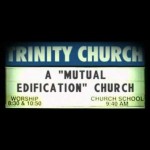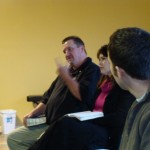Cullmann: Edification, the Body of Christ, and Christ Himself
In my previous post “Cullmann on ‘The Aim of the Service,'” I quoted Oscar Cullmann’s book Early Christian Worship (London: SCM Press, 1953). In that book, Cullmann concludes that there are many, many different activities that happened when the church met together. He also concludes that the “aim” (purpose) of that gathering is edification (or “building up”).
Cullmann points out that the only limitation that Paul places on the wealth of activities that might happen when the church meets is the filter of edification.
Now, a few pages later, I come across another section of Cullmann’s book in which he discusses the work of edification in the church gathering. Cullmann connect edification with the formation of the body of Christ and the presence of Christ himself when the church meets:
First, what is the specifically Christian aim of the gathering for worship? The occasions serve for the ‘building up’ of the community as the Body of Christ, the spiritual body of the risen Lord. The Church as the body of this Christ must take shape in the gatherings of the community. The Church is built up in virtue of its coming together. But because the Church, which is thus built up, is the spiritual body of the risen Christ himself, we can also say that Christ is shown forth in the gathering of the community: where two or three are gathered in Christ’s name, there is Christ in the midst of them, indeed, in such a way that he takes form in the gathering itself. Everything which furthers a ‘building up’, so understood, and only this, belongs to the Christian service of worship. This aim purifies the Christian service of those elements which serve only to satisfy profane, egocentric human needs, but at the same time excludes all excessive enthusiasm which would empty the service in its attempt to purify. The purpose of building up the Church as the body of Christ is served by all the different parts we have identified in the early Christian gatherings: breaking of bread, reading, proclamation, confession, prayer, doxology, blessing, hymns in liturgical and free form; prophecies, speaking with tongues and interpretation of tongues subjected to examination. (pages 33-34)
What do you think of Cullmann’s discussion?
Mutual Edification and the Church: Example
As I “introduced” in a previous post, I believe that Scripture clearly points out that the church should assemble (whenever believers get together) for the purpose of “mutual edification.” Scripture does not tell us exactly what actions should be taken when the church meets. But, in this series, I am attempting to show that Scripture demonstrates the purpose of the gathering of the church through example, principle, and command. In this post, I examine examples in Scripture of the church gathering together for the purpose of “mutual edification.”
Looking at examples from Scripture of the church assembling for mutual edification is both the easiest and hardest of the three (example, principle, and command). It is easiest to examine because there are so many examples. It is the hardest of the three because of context.
What do I mean by context? Well, when Luke was writings Acts (the location of most examples), he was concerned with the continuing work of Jesus Christ through the apostles, primarily Peter and Paul. Thus, he usually talks about what the apostles did when they were with the church. However, if we look at what Luke said, we find that the apostles were not working alone when they were with the church.
For example, consider Acts 13:1 where several people are listed as “prophets and teachers” among the church in Antioch. In Acts 15, we see that “men from Judea” (obviously among others) were “teaching the brothers and sisters” (Acts 15:1). After Paul and Barnabas went to Jerusalem, they met with the church, and again we see several people speaking to the church (Acts 15:4-5). Because of the questions raised by the conversion of Gentiles, the whole church in Jerusalem (including the apostles and elders and others from Antioch) worked together to come to a solution (Acts 15:6-22).
The Jerusalem church sent a letter to the churches of Antioch, Syria, and Cilicia. But, they didn’t just send the letter back to Antioch with Paul and Barnabas, they also sent along Judas (Barsabbas) and Silas. The church in Antioch rejoiced because they were encouraged (Acts 15:31). Then, Judas and Silas (who were not “members” of the church in Antioch in the modern or traditional sense) continued to “encourage and strengthen” the church in Antioch (Acts 15:32). But, Judas and Silas were not the only ones prophesying and teaching in Antioch in order to strengthen the church. We also read the Paul and Barnabas were teaching “along with many others” (Acts 15:35).
An important example is found in Luke’s description of Paul’s work in Ephesus. As usual, Paul began by proclaiming Jesus and making disciples in the Jewish synagogue meetings:
And he entered the synagogue and for three months spoke boldly, reasoning and persuading them about the kingdom of God. (Acts 19:8 ESV)
The practice of allowing several people to speak and discuss and argue during the synagogue meetings seems to have been common during the first century. (For example, we see Jesus speaking often in the synagogue, even though he was not officially a rabbi. We also see Paul and Barnabas being offered the opportunity to encourage the Jews when they visited the synagogue in Pisidia in Acts 13:14-15.) (By the way, there is other evidence – outside of the NT – that confirms that discussions about Scripture were common practice in the first century synagogues.)
When the Ephesian Jews decided that they did not want to hear about Jesus any longer, Paul and the other disciples starting meeting elsewhere. But notice that they continued “reasoning” or “discussing” together in their new meeting location:
But when some became stubborn and continued in unbelief, speaking evil of the Way before the congregation, he withdrew from them and took the disciples with him, reasoning daily in the hall of Tyrannus. This continued for two years, so that all the residents of Asia heard the word of the Lord, both Jews and Greeks. (Acts 19:9-10 ESV)
For two years, Paul met with believers in the hall of Tyrannus where they “reasoned” (from the Greek verb often translated “discussed”) together. This discussion did not just happen at the beginning, when Paul was trying to convince them of the veracity of his message (notice that they were already disciples). Nor did the discussion only take place after the disciples had matured and learned enough information. Paul used discussion as a means of teaching disciples from the very beginning.
We see another example of Paul discussing with believers in the church when he met with the church in Troas on his way back to Jerusalem:
On the first day of the week, when we were gathered together to break bread, Paul talked with them, intending to depart on the next day, and he prolonged his speech until midnight… And when Paul had gone up and had broken bread and eaten, he conversed with them a long while, until daybreak, and so departed. (Acts 20:7, 11)
The verb translated “talked” and “conversed” above is the same verb translated “reasoning” in Acts 19:9. It indicates a two-way conversation. Paul had a discussion “with them” in Troas. This was not a long-winded lecture on the part of Paul.
(As a side note, if you follow the narrative in Acts 20:7ff, you get a good picture of the church meeting in Troas. They talked together for a while, then they ate a meal together, then they continued talking together. However, the length of the discussion was probably longer than usual because of Paul’s presence.)
Through these examples, we see that when early Christians met together, several people spoke in order to encourage or strengthen the church. The people speaking were not always the same people, and often they were “strangers” (but still considered brothers and sisters).
These are a few of the examples that we find in Scripture of the church meeting together for the purpose of “mutual edification.”
———————————————-
Mutual Edification and the Church Series
Cullmann on “The Aim of the Service”
In my study of the early church (between the time of the apostles to the middle ages), I’ve started reading Oscar Cullmann’s classic Early Christian Worship (London: SCM Press, 1953).
So far, Cullmann continues to call the church gathering by the term “worship” or the phrase “service of worship.” You’ll see the terms used below.
But, pay close attention to what Cullmann says about the “aim” of this “service of worship”:
The Aim of the Service
We are now familiar with the various elements of the service of worship in early Christianity. They are extraordinarily numerous, and it is astonishing how many forms the life of worship in these first Christian communities has assumed. In the light of this wealth of form, we must assert here and now that the services of worship in the Protestant Churches of our own era are very much poorer, not only in respect of the free working of the Spirit, but also in respect of what is liturgical and especially in respect of what is aimed at in the gatherings of the community. The aim is constantly described by Paul as building up of the community (1 Cor. 14). We must not interpret this word in the hackneyed pietist sense of ‘uplift’, but we have to think of the figure of the body of Christ, which must be formed effectually in the community. All the different elements which we have examined individually are subordinated to this purpose, which attains its peak in the ‘coming of Christ’ in the Lord’s Supper. To this aim is due the wealth and the variety of the elements in the early Christian service. But, on the other hand, in view of this aim their use is constantly brought under examination and, if necessary, limited. Paul has also seen this second necessity; he has recognized the danger of this wealth, but he has not thrown out the baby with the bath water. On the contrary, he has preserved everything which can contribute to the ‘building up’ of the body of Christ. (pg. 26)
What do you think of Cullmann’s statement?
Mutual Edification and the Church: Introduction
“Scripture does not tell us how the church should meet.”
I’m sure that you’ve read statements like the one above before. And, technically, the statement is correct, as far as it goes.
You see, you will not find any command in Scripture in which the church is told to do certain things, say certain things, pray certain things, teach certain things, etc. when they meet together. Read and read and read as much as you want, and you just won’t find that kind of instruction in Scripture.
And, that’s what we want, right? We want things spelled out for us so that we know that we’re doing it right. The problem is, that’s not what the writers of Scripture were concerned about.
You see, they understood something that is difficult for us to understand. The church is people – really and truly and not just a slogan. So, when the church gathers together, that meeting will look different from gathering to gathering for one simple reason: the people are different. The people have different gifts and talents and concerns and struggles and abilities and preferences and etc.
When the church gets together, the form and shape and method and happenings of that meeting will depend upon the people who are involved.
Yes, I know that this flies in the face of modern Christianity and church methodology. But, if the church really is the people, then it is true that the meeting will change as the people change.
However, just because the authors of Scripture were not concerned with the specific things that happened when the church met together does not mean that they were not concerned with the church gathering together. In fact, I think they were very concerned.
It is correct for us to say that Scripture does not tell us how the church should meet together. It is completely incorrect to say that Scripture does not tell us why the church should meet together. Scripture is very clear on the purpose of the brothers and sisters in Christ gathering together, whenever they gather together.
Several different terms are used to describe this purpose. I like the term “mutual edification,” because it takes into account both important parts of this purpose. 1) “Mutual” indicates that the purpose of the gathering is carried out by many people working together. 2) “Edification” indicates that the purpose is some type of growth or building up of the people involved.
For the next three posts, I’m going to unpack how Scripture indicates to us that “mutual edification” is the purpose of the gathering of the church. Scripture spells this out through example, through principle, and through command. I think that only one of these (example, principle, command) would be sufficient, but we have all three in the pages of Scripture.
I’m going to make one final claim. I’m not going to back this up in this post, since it is impossible to prove a negative. Scripture does not give us any other purpose for the church meeting together other than mutual edification. (I’ve asked for examples to prove me wrong, and I haven’t received any examples from the New Testament that specifies a different purpose for church meetings.)
If the purpose of the church gathering together is so that we can all build up one another, then we should be concerned if that’s not the reason we are gathering with the church today. I hope this series helps demonstrate why I think Scripture is clear when it comes to mutual edification and the church.
———————————————-
Mutual Edification and the Church Series
Spiritual Maturity is not Linear
As many of my readers know, I’ve very concerned that when most churches meet together, their goal is not mutual edification. I believe that whenever we get together with other brothers and sisters in Christ, we should seek to build up one another together.
Also, you may know that I define “edification” or “build up” as helping someone grow in Jesus Christ – that is, helping someone become spiritually mature.
However, I do not think that spiritual maturity is linear. What do I mean? Well, when it comes to age, maturity is linear. We grow older in a linear fashion; we never become less old, always more old. (I’m talking about age maturity, not necessarily emotional or mental maturity.)
But, when it comes to spiritual matters, I do not believe that maturity is linear. It is possible for us to be more or less spiritually mature at different times in our lives.
Thus, when we “mutually edify” one another, we recognize that no one has reached a certain level of maturity never to need help again. Instead, we are always seeking to help one another grow through whatever is happening right now in a person’s life. Past experiences can be helpful and can teach us, but they are not a guarantee that a person has grown past that experience.
Why is this important? We need to understand that discipleship is dynamic, flexible, and often repetitive. If we lose sight of this, we can become impatient or even unforgiving. We could think or say something like, “I just helped him with that issue, why does he need help again?”
This is also a good reason for community involvement – the “mutual” part of mutual edification. At any point in time, each person who is part of the community will be dealing with different issues. No one person is always “the spiritually mature” person in the community.
While there may be – and probably should be – a sense that someone is gaining ground in the area of spiritual maturity, we should never view spiritual maturity as a set of steps that, once we take one step we will never have to face that issue again.
Mutual edification in Romans?
But, I thought Romans was a theology book?
Well, my friend Jason from “Second and Content” wrote about “Mutual Encouragement [in] Romans 1:8-15.” You may remember Jason from the videos interviews that we’ve been doing (see part 1 and part 2 – we’re hoping to tape part 3 this weekend).
According to Jason, Paul begins his letter to the Romans with a desire to get together with them so that they can all mutually encourage one another. Of course, Jason gets that from this sentence in Paul’s opening section:
For I long to see you, that I may impart to you some spiritual gift to strengthen you -Â that is, that we may be mutually encouraged by each other’s faith, both yours and mine. (Romans 1:11-12 ESV)
Wow… Paul was expecting these Roman Christians to encourage him, just as he was expecting to be an encouragement to them. Paul? The great theologian and missiologist? How could someone have anything to offer him?
Well, because Paul knew that those Roman Christians were indwelled by the Holy Spirit, just like Paul was. That is the only ingredient necessary for mutual edification, assuming of course that we don’t get in the Spirit’s way.
Read Jason’s post. He also of really good things to say.\
(By the way, congratulations to Jason on graduating from college today!)
“Mutual Edification” as a label
I found an interesting article in “The Christian Chronicle” called “Who are we?” The article was by Bobby Ross, Jr. and was published in the March 2007 issue. The topic of the short article is non-institutional churches in the Churches of Christ denomination.
The article lists three different types of non-institutional churches in this denomination: 1) Non-class churches, 2) One cup churches, and 3) Mutual edification churches.
This is the description of the “mutual edification churches”:
Mutual edification churches comprise the smallest segment of non-mainstream congregations. The directory lists 124 of these congregations, mostly in the Midwest. Like many one-cup and non-class churches, mutual edification churches believe in allowing the men of the congregation to preach and lead singing, rather than hiring exclusive “preachers.”
But unlike the non-class and one-cup brethren, the mutual edification churches believe in Sunday school and multiple cups.
“Mutual edification or ministry to us means involving the members in an active ministry,” said Barry Poyner, an elder at the Kirksville, Mo., church and author of the book One Another Christianity: Mutual Edification. “I’m persuaded we are happier when active.”
He added: “I find that many churches cannot afford a full-time preacher even if they wanted one. The book is designed to get people to think about different models. … Mutual edification is a Bible-centered practice that could free up our ‘full-time’ ministers to do the work of evangelizing – reaching lost souls.”
Just for the record, the description above is NOT what I mean when I say “mutual edification.” Although, there are certainly some good things said in the description.
It is interesting what happens when people select certain labels to describe themselves. The label takes on the description of the group, instead of the group looking like the phrase used in the label.
What do you think?
Simple, Relational, Powerful
Often, people ask me what our church meetings are like. I’ve described them a few times here. But, given the hybrid structure of our church, our meetings are often more programmatic and structured and complex. Some people want to know what a church meeting would look like if it was simply a group of believers meeting together in a home.
Last Sunday, our family gathered together with two other families in one of their homes. We read and discussed Scripture together. Asked questions. Listened to one another. Sang a song – a carol requested by one of the children. Prayed. Shared a meal – beef stew, red beans and rice, and some brownies. And continued talking about what God was doing in our lives and where we see him leading us. Primarily, we enjoyed one another’s company in Christ and helped one another grow in maturity in Christ.
We’ve known these two families for a few months. (I’ve known one of the husbands longer.) We first met them when they desired to begin meeting in their neighborhood for the purpose of building the kingdom of God there. Their church was not interested in helping them, so we said that we would. They met with us for a while, then began meeting on their own.
It was encouraging to hear these two families talk about their efforts in showing God’s love to their neighbors and co-workers and to share what God had been doing in our lives. Already, they’ve served people in many different ways. We talked about how we can continue serving God together by reaching out to and serving hurting people in our community.
It truly was a simple, relational, powerful time of getting together as the church with our brothers and sisters in Christ.
Taking the Next Step
A couple of weeks ago, I wrote a post called “The Next Step.” In that post, I talked about how important it is for us to talk about service and to encourage one another to serve others. But, I wondered out loud what it would look like – and what it would mean for the church – if we actually took the next step and left to serve others directly from our meeting together.
This is what I called “the next step” – the step away from concept and toward action. The step away from talking about discipleship and service toward actually discipling and serving others. I wrote:
Imagine, we’re sitting together as the church (either around tables or in a circle), and someone expresses a struggle with sharing the gospel with a neighbor. We encourage the person and pray for him or her. Then – the next step – someone offers to go with that brother or sister (perhaps at that very moment) to share the gospel with the neighbor. Or, perhaps someone else offers to take the struggling brother or sister along on a trip to the food pantry when the gospel is often shared.
There are so many possibilities, but it means taking the next step – the step away from concept and toward action.
Well, last Sunday, we started taking that step.
During the month of November, out teaching/discussions on Sundays with the church have focused on the great commandment and the great commission. We’ve primarily exhorted and challenged one another to think about how we can take the community that we share in Christ out to others. We’ve talked about taking our “shared life in Christ” to those who are also in Christ but do not share community with others, and we’ve talked about taking our community to those who are not believers.
Last Sunday, Rodney was planning to lead our teaching/discussion time. He sent an email before Sunday letting everyone know what we would be talking about, so that we could all come prepared. Here is part of his email:
How can we, practically and specifically, help each other to abide in Chirst (and thereby fuel our love for God and our love and service to others in the name of Christ)? To help us be practical and specific… what ways have others helped you grow in your faith, trust, and obedience to Christ? And in what other ways could others help you? (emphasis in original email)
So, when we got together, we did talk about practical and specific way that we could help others and ways that we could be helped. Several people shared opportunities that they’d had in the last couple of weeks to demonstrate the love of God, or times when they’d witnessed and been encouraged by others as they loved and served in the name of Jesus.
Slowly, a few people began making suggestions about how we could specifically serve others. One sister told about an opportunity to spend time in a local hospital. Another sister shared about a family who was having financial problems. A brother shared about his neighbor. A couple of sisters talked about the elderly people they see during the week. The church could serve all of these people in some ways.
Then, a young lady – a teenager actually – spoke up. She had gone with us when we had provided “More Meals” to some of the needy people in our area. She remembered that one of the elderly ladies that we had visited needed her yard raked.
And, this is where we took “the next step.” Margaret, my wife, suggested that whoever was available that afternoon could go to this lady’s house and rake her leaves. Everyone thought this was a great idea! So, we ate lunch together, then several of us (about 14) went to the lady’s and raked the leaves in her yard.
The lady was so surprised and grateful! Margaret and another friend (and our daughters) will continue to see this lady and her husband at least once per week. They will continue to be able to impact their lives with the love of Christ. And, now, because we took the next step, the whole community is involved in this couple’s life!
I’m praying that we continue to take the next step.
How many should speak?
There’s a good discussion over at Eric’s blog “A Pilgrim’s Progress” and his post “Six Sacred Cows.” While most add “sacred cows” to Eric’s list, one commenter disagrees with Eric’s statement concerning “the sermon.”
Here is Eric’s statement:
5. The Sermon
Each week as churches across this country gather, one man will stand up in front of the assembly and “bring a message from God.” Wow. That sounds impressive. The problem is that, as we have seen before, this is not a N.T. church practice. Simply put, one-direction preaching didn’t happen in early church gatherings.
This is a massive sacred cow. If you challenge it, be ready for a not so friendly response.
When the early church gathered, we see many people sharing teachings from scripture. This may have been pastors, but maybe not. Many people taught; nobody preached – especially not a sermon like we see today.
Here is my comment and my addition to the discussion:
If we only look at 1 Corinthians 14:26-40, we see at least 7 people speaking: three speaking in tongues, at least one (possibly more) interpreting the tongues, and at least three prophesying. However, Paul also includes that others should weigh the prophecy… so that would be more than 7 people speaking. As you’ve mentioned, Paul does not tell us how many should bring psalms or teaching. Let’s assume he would use the same principles: that would mean 3 people bringing songs/psalms and 3 people teaching. So far, we’re up to at least 13 people speaking when the church meets, just from 1 Corinthians 14:26-40. That’s certainly more than I’ve seen at every church that I’ve met with (except one).
But, there’s another part of this discussion. When we say someone teaches, we usually think of lecture style teaching, which means that one person speaks and everyone else is quiet. Is that what Paul meant? Perhaps. But, perhaps not. We have several examples of Paul speaking to unbelievers. But, we don’t have many example of how Paul taught the church. There are two striking examples however.
1) In Acts 19:9, we see Paul and the disciples of Jesus leaving the synagogue to meet in the Hall of Tyrannus (not a home, by the way). It says that Paul continued “reasoning” with them (according to the ESV). This same verb is used to describe Paul’s speech among the Jews in the synagogue in Acts 19:8. What does this verb mean? Well, it has a wide range of meaning, but it is the source of our verb “dialogue”. It could mean anything from a dialogue between two people to a discussion between many, to an all out argument. In essence, the verb indicates that more than one person was taking part in the speaking.
2) Using the same verb (dialegomai, if you’re interested) Luke describes how Paul spoke to the church in Troas in both Acts 20:7 and Acts 20:9 (translated “talked” in ESV).
In both of these examples of Paul speaking to the church, a verb is used to indicate dialogue or discussion. How many people were speaking during this time? It’s hard to say.
So, just looking at these three passages, it seems clear that several people spoke (in order and without chaos) when the church met in the NT.
What do you think? When the early church met, did they meet to listen to one person speak, or did they meet to speak to and with one another – that is, many people speaking (decently and in order, of course)?








